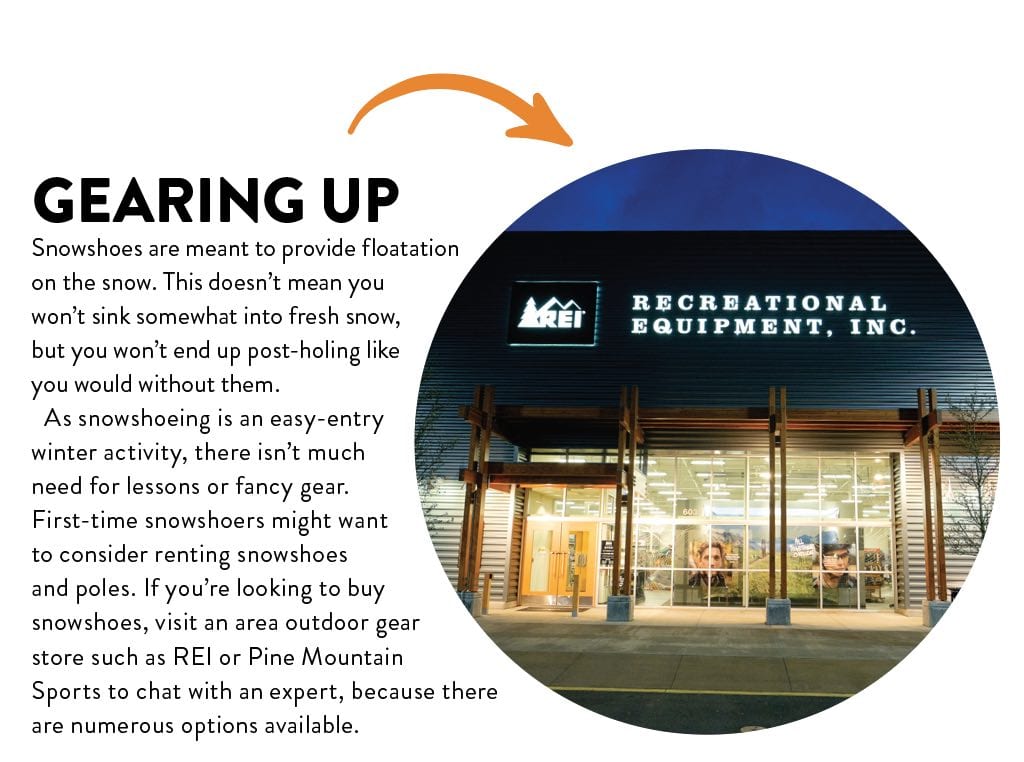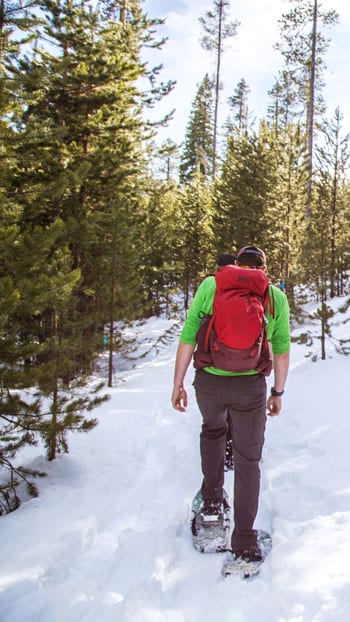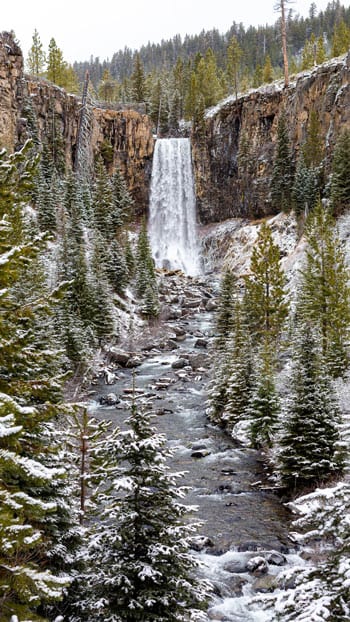There is an old adage, “If you can walk, you can snowshoe.” This bodes well for a popular winter activity that, truly, the whole family can share. Entry into the world of snowshoeing requires little more than some general fitness, minimal equipment and a desire to explore Central Oregon’s winter wonderland. “If you’re asking, how can I get outside on the snow, inexpensively, safely and easily, snowshoeing is the answer,” said Henry Abel, of the Pine Mountain Sports community outreach staff.
Brief History of the Shoe
Thousands of years ago our Neolithic ancestors traversed across snowy landscapes in search of game or shelter. Tired of post-holing through the snow, some archaic individual came up with the idea of binding slabs of wood or thick bark to his or her feet with leather. The oldest known snowshoe was found by an Italian cartographer in 2003 while mapping the Gurgler Eisjoch glacier at an elevation of 10,280 feet in the Dolomites. The oval-shaped, birch wood frame still had pieces of natural cordage attached and carbon-dating placed the snowshoe’s age at around 5,800 years old.
From there, snowshoe evolution has led us to ergonomic ‘shoes made of lightweight materials such as tubular aluminum frames, neoprene or plastic decking, and easy-to-use bindings. Heck, you can even get snowshoes sporting a Michelin tire tread.

So, if you’re thinking about taking down those vintage wooden Alaskan snowshoes with the rawhide webbing hanging above the fireplace mantle, don’t do it. They are cumbersome and challenging to wear—great for the historic Alaskans, maybe, but these days we can do a lot better.
What to Wear
Similar to hiking, snowshoeing offers an outdoor aerobic workout. “I tell my beginner groups that on a good day, snowshoeing is twice as hard as hiking,” said Leslie Olsen, outdoor recreation leader for Bend Park & Recreation District. “It’s a great way to get in a workout while seeing a beautiful landscape.” As with any outdoor activity, Olsen encourages folks to be prepared and know their limits. “Being prepared is like wearing a seat belt. You’re glad to have it on the one time you need it.” Dress in layers to add or subtract clothes and utilize microfleece and non-cotton clothing for its insulating value and comfort. Waterproof boots, pants and a shell also offer protection from the elements.
“You’re probably going to start out cold then warm up quickly,” added Abel of Pine Mountain, so having a daypack to stuff extra clothes into, along with some water and snacks, is a good idea.
There is an old adage, “If you can walk, you can snowshoe.” This bodes well for a popular winter activity that, truly, the whole family can share. Entry into the world of snowshoeing requires little more than some general fitness, minimal equipment and a desire to explore Central Oregon’s winter wonderland. “If you’re asking, how can I get outside on the snow, inexpensively, safely and easily, snowshoeing is the answer,” said Henry Abel, of the Pine Mountain Sports community outreach staff.

I’m In. Where do I begin?
The beauty of snowshoeing is that as long as there is enough snow, you can literally go anywhere: city parks, neighborhoods or up to the mountains.
We can all thank Jim Davis (1926-2014), a doctor who retired in Bend, for establishing snowshoe trails at sno-parks along the Cascade Lakes Highway starting in the early 2000s. “In the winter, Jim would take his map and compass to avoid snowshoeing on the ski trails,” said Fred DeCook, retired Bend resident who, along with others, helped Davis set up the initial trails. “He started to find that people were following his tracks, so Jim went to the Forest Service and asked if he could put in some dedicated snowshoe trails.” With the Forest Service’s OK, Davis and his group of volunteers flagged routes that the Forest Service would then vet and approve as a trail. After approval, the crew installed trail markers—blue diamonds with a snowshoer icon—with aluminum nails. Today, Central Oregon Nordic Club volunteers provide stewardship along 23.5 miles of snowshoe trails in cooperation with the Forest Service.
Virginia Meissner Sno–Park

Located 15 miles from Bend along the Cascades Lake Highway, this sno-park was named in honor of Virginia Meissner, a long-time Central Oregon resident who taught cross-country skiing and introduced many people to the outdoor wonders of the area. Originally known as the Tangent area, this is the first sno-park winter enthusiasts encounter on the road to Mount Bachelor.
The Ponderosa Loop is 3 miles long and follows the rolling terrain through ponderosa and grand fir forests to the Meissner warming shelter, which is a perfect spot to enjoy a snack or lunch or to howl at the full moon.
Swampy Lakes Sno-Park
A few miles above Meissner Sno-Park is Swampy Lakes Sno-Park. Often less crowded than Meissner, this area offers two great snowshoe destinations: Swampy Lakes Shelter and the Nordeen Shelter, named after local legendary ski pioneer Emil Nordeen (1890-1986).
The Swampy Lakes loop starts at the trailhead sign and travels west towards Swampy Lakes. This trail has rolling terrain, passes through mixed conifers, and leads to the new Swampy Shelter which was built in 2016 (the old one was leaning too far left, seriously). The Porcupine Loop is 3.5 miles long, and if you’re up for a cardio burn, take the Telemark Butte alternate route on your return trip for a 4.25-mile-long loop.
The Nordeen Shelter trail also begins at the trailhead and heads east through lodgepole pine stands and open meadows before ending at the shelter. Part out-and-back, part loop, the 4.75-mile-long trail is relatively level most of the way. There are views of the rocky face of Paulina Peak in Newberry Volcanic National Monument from the shelter.
Edison Sno-Park

This sno-park includes some “electric” routes such as the Direct Current Trail, Tesla Trail, Light Bulb Loop and High Voltage Trail. “The Edison area is my favorite because dogs are allowed and there are a lot of rock formations the trail winds around,” DeCook said. Located along U.S. Forest Road 45, there are several options to tie trails together to visit both the Edison and AC/DC Shelter (for alternating and direct current, not the band). The longer Tesla Loop to the Edison Shelter is 5 miles and the Short Loop to the Edison Shelter is 3 miles long.

Todd Lake
Two trailheads lead to Todd Lake. Many snowshoers prefer starting at the Mt. Bachelor Nordic Center and, after obtaining a free corridor pass, ‘shoeing down the Common Corridor instead of parking at the Dutchman Flat Sno-Park and navigating through snowmobile traffic. The trail to Todd Lake traverses through a magnificent old growth mountain hemlock forest. After a fresh snow, some of the younger trees sport headdresses of snow which give them a gnome-like appearance. After descending to Todd Meadow, the trail winds along the outlet for Todd Lake which, depending upon snow depth, may have a fluted appearance as the creek becomes entrenched within walls of snow. Expect visiting Canada jays to swoop in on any unprotected sandwich or snack. Loop is 3.75 miles.
Skyliner Sno–Park
This sno-park is located 19 miles from Bend along Skyliner Road and offers a couple of options to reach Tumalo Falls. To make the 6.0-mile loop, follow the Tumalo Creek trail to the falls and return via the closed road or just snowshoe out and back on the closed Tumalo Falls Road. The 100-foot-high Tumalo Falls may be framed by ice as it plunges over a basalt ledge.

Pro Tips
• A sno-park permit is required November 1 to April 30 for parking at a sno-park. Annual or day pass options are available, and the pass helps support plowing and restrooms.
• Sno-parks on the north side of the Cascade Lakes Highway are closed to dogs but sno-parks on the south side are open to dogs.
• Obtain a free corridor trail pass at the Mt. Bachelor Nordic Center for the Common Corridor and remember to stay off the groomed trails.
• Be prepared. Bring the ten essentials, extra batteries for your headlamp if snowshoeing at night, and always let someone know where you are headed.
• Zip your cellphone pocket closed before creating a snow angel.
• Phone batteries may lose charge in the cold, so consider bringing the waterproof/tearproof Bend Area Trails map by Adventure Maps as a backup, or as a primary for us old schoolers out there.
Learn more about these six nearby trails to snowshoe this winter. Read all about snow sports, trails and fun to be had in winter with us here.





